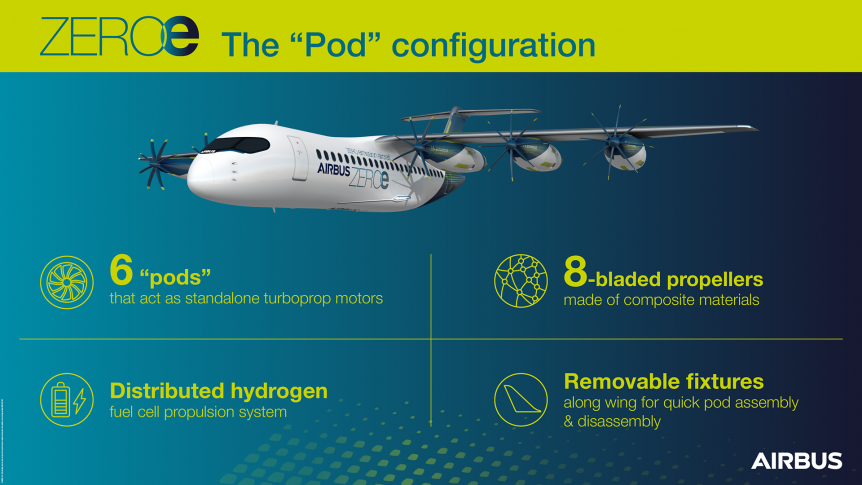Airbus announced its Zero E program in late September, showing three possible candidates for hybrid hydrogen power. Zero E, for zero emissions, is a tall order even for one of the world’s two largest aircraft companies. Now, the company makes yet another announcement – for a novel modular “pod” configuration – “a stand-alone propeller propulsion system powered by hydrogen fuel cells. It consists of the following elements:”
- A propeller
- Electric motors
- Fuel cells
- Power electronics
- LH2 tank
- A cooling system
- A set of auxiliary equipment
Instead of housing the hydrogen fuel in the fuselage, Airbus creates a more spacious cabin by moving fuel storage to each pod. Each pod would be identical and modular. Components could be removed and replaced quickly, and if necessary, the entire pod could be removed for maintenance. One startling possibility, that of dropping a pod if it caught on fire, would probably not be well received in areas of dry forests or brushland.
Liquid hydrogen and atmospheric oxygen combine in the fuel cells to generate electric current and run the motors. Eight-bladed composite propellers shaped to “provide added thrust during the takeoff and climb-out phases of flight” would mean high performance and lower “fuel” usage.
Glenn Llewellyn, VP of Zero-Emission Aircraft, explains, “This is one option, but many more will be conceptualized before we make a final selection, a decision that is expected by 2025.”
Addison Schonland’s interview with Airbus Chief Technology Officer Grazia Vittadini sheds light on what the aviation giant hopes to accomplish with H2. They discuss operating costs, environmental concerns, and other aspects of hydrogen use. They mention Elring Klinger fuel cell stacks at one point, a possible indication of future suppliers.
Don’t look for this on flight lines any time soon. Glenn Llewellyn points out, “This is one option, but many more will be conceptualized before we make a final selection, a decision that is expected by 2025.” This is an idea pursued since at least 2018, when a recently published patent on the technology had its first application.
A Year-end Projection: Where Hydrogen May Go Next
GreenTech Media.com shows us major advances in hydrogen production and applications, something we might not have seen coming a few years ago. It’s a year-end reminder that the future might really get better – at least in the energy field.

